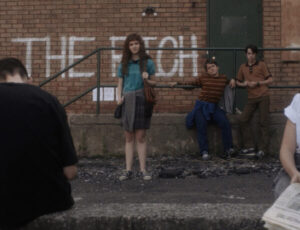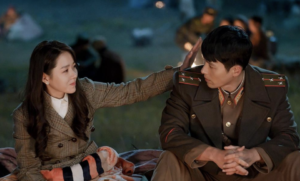In 2012, feminist performance art, punk rock collective Pussy Riot nabbed international headlines when they were arrested for a protest inside the Moscow Cathedral of Christ the Saviour. Filmmakers Mike Lerner and Maxim Pozdorovkin decided to bring their cameras to Russia and capture as much information about the arrested members and their trial as possible. Their film, Pussy Riot: A Punk Prayer (2013), though largely uneven, provides insight into the controversial group and reveals the political firestorm that erupted during the trial of Nadia Tolokonnikova, Katia Samutsevich and Masha Alyokhina.
Rather than opening with histories or explanations, the film jumps right into the action, and focuses on Pussy Riot’s now infamous performance in the Cathedral. Before the performance, many people outside of Russia did not know who Pussy Riot was. The group is made up of a fluctuating number of like-minded feminist artists around Moscow who throw together guerilla performances to shake up the public. After their Cathedral protest, three members of Pussy Riot were arrested and tried. The trial, considered by most to be a farce and a piece of political theatre, served to make an example of the three women. Their lawyers explain that part of the reason their performance received so much negative attention is because Russia does not have a history of performance art. As such, there was a fundamental misunderstanding over what they were trying to achieve. For instance, rather than having their actions viewed as a protest against Vladimir Putin and Russia’s corruption, it was understood as the work of blasphemers striving to destroy the church and its followers.
The first half of the film is as loud and abrasive as Pussy Riot’s music, but its punk rock values do little to support its storytelling. We are tossed around between performances, interviews and random conversation captured while Tolokonnikova, Samutsevich and Alyokhina talked to friends and reporters pre-trial. This mashup of elements is at times difficult to follow, and failed to grip me because the information provided had no context (i.e the history of Pussy Riot, why the performance was so controversial etc.) until nearly halfway through the film.
The film picks up once Pussy Riot enters the courtroom. The cameras bear witness to the violent split between two groups of Russian citizens: conservative members of the Orthodoxy, and liberal Russians who support freedom of speech. Members from each group are stationed outside the court at every hearing, shouting either for the women’s punishment or release. Lerner and Pozdorovkin were also able to secure interviews with the women’s parents and through them we finally learn about their daughters’ lives before their arrest, and how they came to be in Pussy Riot. Inside the courtroom, we hear impassioned and intelligent arguments put forward by Tolokonnikova, Samutsevich and Alyokhina, as well as candid conversations the women have between each other. Much of the court footage was received from RIA, the Russian News Agency, who had captured these interactions while the women waited in their glass holding cell for the trial to begin. These conversations reveal their awareness of how they are perceived, and also their hopes, fears and expectations as the trial proceeds.
Although structurally weak, Pussy Riot: A Punk Prayer’s insight into its subjects is its saving grace. Lerner and Pozdorovkin’s cameras succeed in capturing Russia’s pulse, and reveal the seething layer of unrest just beneath the surface.







